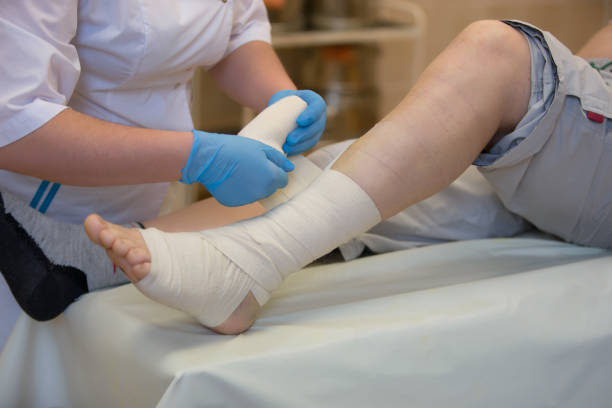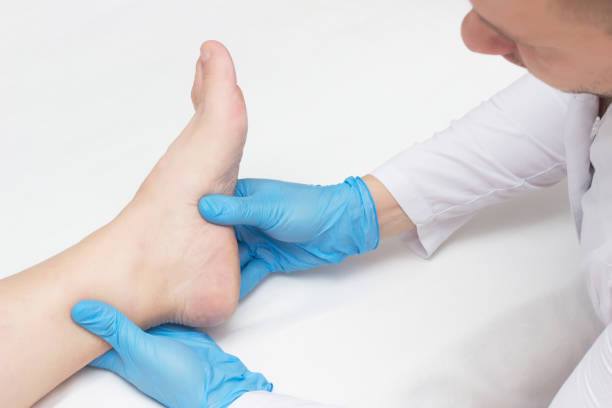Managing Ankle Pain: Effective Physical Therapy Techniques
Ankle pain is a common issue affecting athletes and non-athletes alike, often resulting from injuries, overuse, or underlying conditions. Whether it’s a sprain, strain, or chronic condition, ankle pain can significantly impact your mobility and quality of life. Understanding the importance of addressing ankle pain promptly through effective treatment methods is key to recovery and long-term health.
Understanding the Benefits of Physical Therapy for Ankle Pain
How Physical Therapy Can Help Manage Ankle Pain
Physical therapy (PT) is an essential component in the management and alleviation of ankle pain. Through targeted exercises and specialized techniques, PT focuses on rehabilitation to help restore function, reduce pain, and prevent future injuries. Physical therapists are highly trained professionals who assess the specific needs of each patient, creating customized treatment plans that address the root cause of the pain. By employing a comprehensive approach, physical therapy aims to enhance mobility, improve strength, and ensure long-term recovery.

Ankle Pain Treatment
Types of Ankle Injuries That Can Benefit from Physical Therapy
- Sprains and Strains: These common injuries involve the ligaments and muscles surrounding the ankle joint. Sprains occur when the ligaments are stretched or torn, while strains involve damage to the muscles or tendons. The severity of these injuries can vary from mild to severe. Physical therapy can help by promoting healing, improving strength, and restoring range of motion.
- Tendinitis: Tendinitis is characterized by inflammation of the tendons, often resulting from overuse or repetitive motion. This condition can cause significant pain and discomfort, impacting daily activities. Through a combination of exercises, manual therapy, and modalities such as ultrasound or electrical stimulation, physical therapy can reduce inflammation, alleviate pain, and enhance tendon function.
- Fractures: Ankle fractures, or breaks in the bones of the ankle, require careful rehabilitation to ensure proper healing and prevent complications. Physical therapy plays a critical role in the recovery process by guiding patients through progressive weight-bearing activities, strengthening exercises, and mobility training to restore normal function and reduce the risk of future injuries.
- Arthritis: Arthritis is a chronic condition characterized by joint inflammation, leading to pain, stiffness, and reduced mobility. Physical therapy offers a personalized approach to managing arthritis symptoms by incorporating exercises that improve joint flexibility, strengthen surrounding muscles, and alleviate pain. Additionally, physical therapists can provide education on joint protection techniques and lifestyle modifications to enhance overall well-being.
- Achilles Tendon Injuries: The Achilles tendon connects the calf muscles to the heel bone and is susceptible to injuries such as tendinitis or ruptures. These injuries can significantly impact mobility and daily activities. Physical therapy focuses on reducing inflammation, promoting healing, and gradually reintroducing activities to restore strength and flexibility in the Achilles tendon.
Comparison with Other Treatment Options
While medication and surgery are sometimes necessary for managing ankle pain, physical therapy offers a non-invasive, holistic approach that addresses the underlying causes of the pain. Unlike medications, which may provide temporary relief but come with potential side effects, physical therapy focuses on healing and strengthening the affected area, offering long-term benefits without the risks associated with medication. Surgery, although sometimes required for severe cases, involves inherent risks and a longer recovery period. Physical therapy, on the other hand, emphasizes a comprehensive rehabilitation process that aims to restore function, reduce pain, and prevent future injuries through personalized treatment plans.
Comprehensive Guide to Physical Therapy Techniques for Managing Ankle Pain
Range of Motion Exercises
Range of motion exercises are fundamental in improving the flexibility and mobility of the ankle joint. These exercises are essential for reducing stiffness, enhancing movement, and promoting the healing process. By incorporating these exercises into your routine, you can significantly alleviate ankle pain and improve overall ankle function. Here are some effective range of motion exercises:
- Ankle Circles: Sit or lie down and slowly rotate your ankle in a circular motion. Perform this exercise in both clockwise and counterclockwise directions to ensure balanced movement.
- Heel-to-Toe Walks: Walk on your heels for a few steps, then switch to walking on your toes. This dynamic exercise helps in enhancing the ankle’s range of motion while also strengthening the muscles.
- Alphabet Exercises: While seated, “draw” the letters of the alphabet in the air using your foot. This engaging exercise targets all the muscles around the ankle, promoting better flexibility and movement.
Strengthening Exercises
Strengthening the muscles surrounding the ankle is crucial for providing better support and stability to the joint. Stronger muscles can help prevent future injuries and aid in the recovery process. Incorporate these exercises into your routine to build muscle strength around the ankle:
- Calf Raises: Stand on the edge of a step with your heels hanging off. Slowly raise your heels as high as possible, then lower them back down. This exercise targets the calf muscles, which are vital for ankle support.
- Resistance Band Exercises: Use a resistance band to perform various movements such as ankle dorsiflexion, plantarflexion, inversion, and eversion. These exercises help in strengthening the muscles around the ankle comprehensively.
- Toe Curls: Place a towel on the floor and use your toes to scrunch it up towards you. This exercise strengthens the smaller muscles in the foot and improves overall stability.
Balance and Proprioception Training
Improving balance and proprioception is essential for preventing future ankle injuries. Proprioception refers to the body’s ability to sense its position and movement in space. Enhancing these skills can lead to better coordination and stability. Here are some effective training techniques:
- Single-Leg Stands: Stand on one leg for as long as possible while maintaining balance. Gradually increase the duration and difficulty by closing your eyes or standing on an unstable surface.
- Balance Board Exercises: Use a balance board to perform various movements. This tool challenges your balance and proprioception, helping to improve ankle stability.
- Dynamic Movements: Incorporate dynamic movements such as hopping, agility drills, and lateral jumps. These exercises mimic real-life scenarios and enhance your body’s ability to respond to sudden changes in movement.
Manual Therapy Techniques
Manual therapy involves hands-on techniques performed by a physical therapist to reduce pain, improve range of motion, and promote healing. These techniques are tailored to meet individual needs and can be highly effective in managing ankle pain. Common manual therapy techniques include:
- Joint Mobilizations: Gentle movements applied to the ankle joint to improve its mobility and reduce stiffness. This technique can help restore normal joint function and alleviate pain.
- Soft Tissue Massage: Targeted massage techniques to release tension in the muscles and soft tissues around the ankle. This can enhance blood flow, reduce inflammation, and promote healing.
Use of Modalities for Pain Relief
Physical therapists may utilize various modalities to alleviate pain and inflammation in the ankle. These modalities can complement other therapeutic exercises and enhance the overall effectiveness of the treatment plan. Common modalities include:
- Ice and Heat Therapy: Applying ice can help reduce swelling and numb pain, while heat therapy can relax muscles and improve circulation. Alternating between ice and heat can provide comprehensive pain relief.
- Ultrasound Therapy: This modality uses sound waves to penetrate deep into the tissues, promoting tissue healing and reducing pain. It can be particularly effective for chronic ankle pain.
- Electrical Stimulation: Electrical currents are used to stimulate the muscles and nerves, reducing pain and promoting muscle function. This technique can be beneficial for both acute and chronic ankle pain.
Taping and Bracing Techniques for Support
Using tape or braces can provide additional support to the ankle, preventing further injury and aiding in the healing process. These techniques are especially useful during the early stages of recovery or when returning to physical activity. Common taping and bracing methods include:
- Athletic Taping: Applying athletic tape in specific patterns to stabilize the ankle joint. This technique can provide targeted support and reduce the risk of re-injury.
- Ankle Braces: Using pre-fabricated or custom-made ankle braces to provide consistent support. Braces can be worn during daily activities or sports to ensure the ankle remains stable.

Ankle Treatment
Creating an Effective Physical Therapy Treatment Plan
When it comes to physical therapy, one size does not fit all. Each patient’s condition and needs are unique, necessitating personalized treatment plans that cater specifically to their challenges. An individualized approach not only ensures that the therapy addresses specific issues but also optimizes the recovery process. This bespoke method allows therapists to tweak and adjust the treatment as they gain more insight into the patient’s condition, making it more effective over time. Customizing treatment plans is crucial because it accounts for variables such as the patient’s age, lifestyle, medical history, and severity of the injury, leading to more accurate and beneficial outcomes.
Collaboration Between the Therapist and Patient
Successful rehabilitation is a collaborative effort that requires active participation from both the therapist and the patient. Open communication and regular feedback are essential components of this partnership. A therapist can only devise an effective treatment plan if they fully understand the patient’s experiences, pain levels, and progress. Therefore, ongoing dialogue helps tailor the treatment to the patient’s evolving needs and ensures that any adjustments are made promptly. This collaborative approach fosters a supportive environment where patients feel heard and empowered, enhancing their commitment to the therapy process and ultimately leading to better results.
Incorporating Lifestyle Changes and Home Exercises for Long-Term Management
Effective management of ankle pain extends beyond the clinic and into the patient’s everyday life. Long-term management often involves lifestyle modifications and home exercises that support the therapy received from the physical therapist. Patients are encouraged to adhere to their therapist’s recommendations, which may include maintaining a healthy weight, engaging in regular physical activity, and incorporating specific exercises into their daily routine. Such proactive measures can prevent future injuries and promote overall joint health, offering a sustainable path to long-term wellness. By integrating these changes, patients can significantly improve their quality of life and reduce the likelihood of chronic pain.
Tips for Finding a Qualified Physical Therapist for Ankle Pain
Selecting a licensed physical therapist with expertise in treating ankle pain is crucial for achieving effective treatment outcomes. Licensed therapists have undergone rigorous training and certification processes, ensuring they possess the necessary skills and knowledge. Moreover, experience is a key factor; therapists who specialize in sports medicine or orthopedic therapy are often more adept at handling specific conditions like ankle injuries. Checking credentials and seeking out specialists can make a significant difference in the quality of care received, setting the stage for a successful recovery.
Questions to Ask When Searching for a Physical Therapist
Finding the right physical therapist involves more than just verifying credentials; it’s also about ensuring they’re the right fit for your specific needs. Here are some essential questions to ask:
- What is your experience in treating ankle pain and injuries? Understanding their specific experience can give you confidence in their ability to handle your condition.
- What techniques and modalities do you use? Different therapists may employ various methods, and knowing these can help you gauge whether their approach aligns with your preferences and needs.
- How do you customize treatment plans for individual patients? This question assesses their ability to provide personalized care.
- What should I expect during the treatment process? Having a clear understanding of the treatment journey can help set realistic expectations and alleviate any concerns.
- Can you provide references or testimonials from previous patients? Reviews and testimonials can offer valuable insights into the therapist’s track record and patient satisfaction.
Understanding Insurance Coverage for Physical Therapy
Before beginning treatment, it’s important to verify your insurance coverage for physical therapy services. Understand the costs involved, including what portion, if any, you will need to pay out-of-pocket. Insurance plans vary widely, and knowing the specifics of your coverage can prevent unexpected expenses. Contact your insurance provider to get detailed information about your benefits and consider discussing this with potential therapists to ensure there are no surprises later on.
Maintaining Ankle Health and Preventing Future Injuries
Engaging in physical activities without proper preparation can significantly increase the risk of injuries, particularly to the ankles. This is why incorporating effective warm-up and cool-down techniques into your routine is crucial.
- Warm-Up Techniques: Warming up before engaging in any physical activity serves to prepare your body for the demands you are about to place on it. This preparation is especially important for your ankles, which bear much of the impact during movements. A good warm-up will typically include dynamic stretches—these are active movements that gently take your joints and muscles through their full range of motion. Activities like ankle circles, leg swings, and light jogging can help increase blood flow to the area and gradually increase the intensity, making your ankles more resilient to stress.
- Cool-Down Techniques: After completing your physical activities, cooling down is equally important. This process helps in gradually bringing your heart rate back to normal and aids in the recovery process. Gentle stretches that focus on the muscles and tendons around the ankle can help reduce stiffness and soreness. Cool-down exercises such as slow walking, calf stretches, and seated ankle stretches can be very effective in aiding recovery and preventing injuries.

Ankle Health Maintenance
Using the Correct Footwear and Support for Your Activity
The type of footwear you choose can have a profound impact on the health of your ankles. Shoes that provide proper support and cushioning are essential in preventing ankle injuries. Here’s why:
- Supportive Footwear: When you wear shoes that offer adequate arch support and cushioning, you help distribute the forces exerted on your feet and ankles more evenly. This reduces the likelihood of experiencing undue strain or injury. Different activities may require different types of footwear. For example, running shoes are designed to absorb shock and provide support during high-impact activities, while hiking boots offer stability and protection on uneven terrain.
- Custom Insoles and Orthotics:: If you have specific foot or ankle issues, such as flat feet or high arches, custom insoles or orthotics can provide the additional support you need. These inserts are tailored to your unique foot structure and can help correct imbalances, reducing the risk of injury. Consulting with a podiatrist or orthopedic specialist can help you determine whether custom orthotics are right for you.
Tips for Avoiding Common Ankle Injuries
- Avoid uneven surfaces and high-impact activities if prone to ankle injuries.
- Strengthen and stretch regularly to maintain flexibility and stability.
- Listen to your body and rest when needed to avoid overuse injuries.
Conclusion
In conclusion, managing ankle pain through physical therapy offers numerous benefits, from pain relief and improved mobility to prevention of future injuries. By understanding the various techniques and approaches used in physical therapy, patients can make informed decisions about their treatment and work towards a successful recovery. If you’re experiencing persistent or recurring ankle pain, don’t hesitate to seek professional help. A qualified physical therapist can create a customized plan to address your needs and help you get back to the activities you love.
Flagstaff Foot Doctors: Anthony Rosales DPM
https://www.google.com/maps?cid=8835841318590452161
421 N Humphreys St, Flagstaff, AZ 86001, United States
(928) 774-4825
https://flagstafffootandankle.com/
